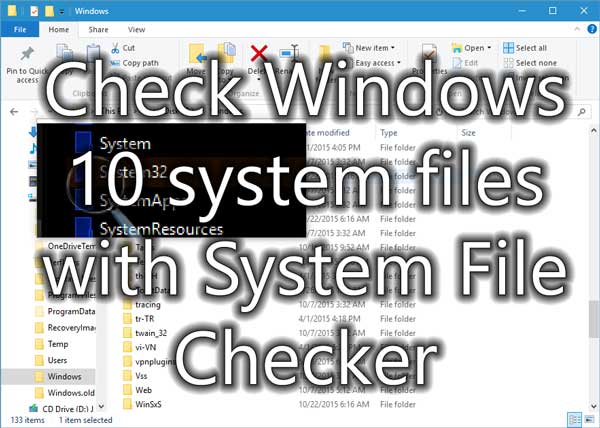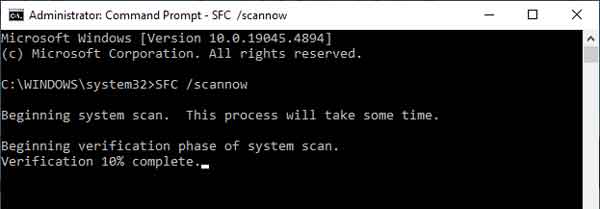Updated July 20, 2020
I was thinking the other day about what program I use the most in doing computer repair. The one program I use the most on Windows computers would have to be System File Checker (SFC). SFC checks for system files that may have gotten corrupt or replaced with incorrect versions. Here's how to check Windows 10 system files with System File Checker.

SFC has been included in every version of Windows since Windows XP. You can also build it into the Microsoft Diagnostics and Recovery Toolset (DaRT). There is no shortcut or link to SFC in Windows 10, as it runs inside an Administrative Command Prompt.
How to open a Command Prompt with Administrator privileges in Windows 10

The following is the syntax and switches for SFC. The most commonly used syntax/switch is: sfc /scannow.
SFC [/SCANNOW] [/VERIFYONLY] [/SCANFILE=<file>] [/VERIFYFILE=<file>] [/OFFWINDIR=<offline windows directory> /OFFBOOTDIR=<offline boot directory>]
/SCANNOW (Scans integrity of all protected system files and repairs files with problems when possible.)
/VERIFYONLY (Scans integrity of all protected system files. No repair operation is performed.)
/SCANFILE (Scans integrity of the referenced file, repairs file if problems are identified. Specify full path <file>.)
/VERIFYFILE (Verifies the file's intergrity with full path <file>. No repair operation is performed.)
/OFFBOOTDIR (For offline repair specify the location of the offline boot directory.)
/OFFWINDIR (For offline repair specify the location of the offline windows directory.)
Examples
sfc /scannow sfc /verifyfile=c:\windows\filetobereplaced.dll sfc /scanfile=d:\windows\filetobereplaced.dll /offbootdir=d:\ /offwindir=d:\windows sfc /verifyonly
Once SFC is done scanning the system files, it will give one of four possible results:
- Windows Resource Protection did not find any integrity violations.
All system files are fine, and you're good to go.
- Windows Resource Protection could not perform the requested operation.
There may be another program preventing SFC from running. In this case, boot the system up into safe mode and run SFC from there.
- Windows Resource Protection found corrupt files and successfully repaired them.
All system files are now correct, and you're ready to go. If you want to view the repair details, see below.
- Windows Resource Protection found corrupt files but was unable to fix some of them.
If you get this message, SFC found a file or files that it couldn't repair. The next thing you will need to do is find out the name of the file(s). Using the Find String utility, you can filter out the SFC results with only the scanned components and create a text file with that information on your Desktop called sfcdetails.txt. Just copy the following code into an Administrative Command Prompt:
findstr /c:"[SR]" %windir%\Logs\CBS\CBS.log >"%userprofile%\Desktop\sfcdetails.txt"
Manually replacing a corrupt system file in Windows 10
Note: To replace a corrupt system file, you will need to have a known good copy of the file(s) in question. A good source for files is another computer or virtual machine running Windows 10. Since I do computer repair for a living, I have all of the versions of Windows that are still supported by Microsoft running inside of Oracle VirtualBoxes.
The first thing to do is note the location (path) and name of the file(s) that need to be replaced from the sfcdetails.txt file. Once you have another copy of the corrupt file(s), you will need to take administrative ownership of the file(s). To do this, modify the following command with the path\filename of the file you want to replace and then type it into an Administrative Command Prompt:
takeown /f path\filename
Example: takeown /f C:\Windows\FileToBeReplaced.dll
Next, you will have to grant administrators full access to the file(s) being replaced. To do this, modify the following command with the path\filename of the file you want to replace and then type it into an Administrative Command Prompt:
icacls path\filename /grant administrators:F
Example: icacls C:\Windows\FileToBeReplaced.dll /grant administrators:F
The third thing to do is copy over the new file(s) and replace the corrupt one(s).To do this, modify the following command with the path\filename of the file you want to replace and then type it into an Administrative Command Prompt:
copy path\filename path\filename
Example: copy C:\Temp\FileToBeReplaced.dll C:\Windows\FileToBeReplaced.dll
9dce3ed5-f4bd-4a23-b404-6e79d7d5bfa0|0|.0|96d5b379-7e1d-4dac-a6ba-1e50db561b04